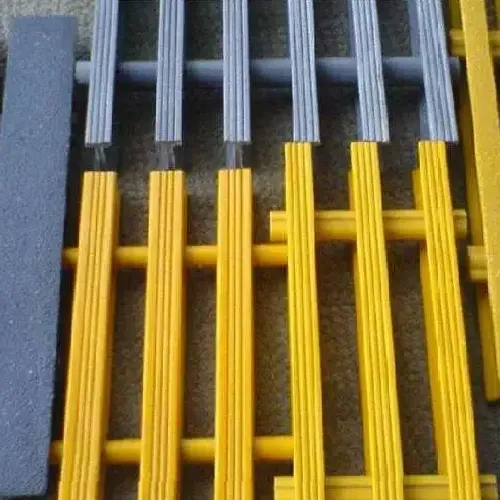loading...
- No. 9, Xingyuan South Street, Dongwaihuan Road, Zaoqiang County, Hengshui, Hebei, China
- admin@zjcomposites.com
- +86 15097380338
- Welcome to visit our website!
fiber reinforced polymer bars
Fiber Reinforced Polymer Bars Revolutionizing Construction and Infrastructure
In the ever-evolving landscape of construction materials, Fiber Reinforced Polymer (FRP) bars have emerged as a transformative solution, offering significant advantages over traditional materials such as steel. This innovative composite material, which incorporates high-strength fibers within a polymer matrix, optimizes structural integrity, durability, and overall performance, making it a noteworthy alternative in various civil engineering applications.
Understanding Fiber Reinforced Polymer
FRP bars are typically composed of a polymer resin matrix reinforced with continuous fibers, predominantly glass, carbon, or aramid. These fibers are known for their exceptional tensile strength and lightweight characteristics. By integrating these fibers into a polymer, FRP bars achieve a remarkable balance of strength-to-weight ratio, corrosion resistance, and flexibility. This unique composition allows them to withstand harsh environmental conditions, making them particularly suitable for use in coastal or chemically aggressive environments where traditional materials might suffer.
Advantages of FRP Bars
The primary advantages of FRP bars can be summarized as follows
1. Corrosion Resistance Unlike steel, which is prone to rust and corrosion when exposed to moisture, FRP bars remain intact and functional over time. This characteristic significantly reduces maintenance costs and extends the lifespan of structures, especially in areas where de-icing salts or chloride exposure is a concern.
2. Lightweight FRP bars are substantially lighter than their steel counterparts, making them easier to handle and install. This lightweight nature can lead to reduced transportation costs and lower requirements for heavy machinery on construction sites.
3. High Strength-to-Weight Ratio Despite their lightness, FRP bars provide impressive tensile strength, allowing designers and engineers to use less material without compromising structural integrity. This efficiency can lead to cost savings in both materials and labor.
fiber reinforced polymer bars

4. Electromagnetic Neutrality FRP materials do not conduct electricity, making them an ideal choice for applications in sensitive environments, such as near electrical installations or in magnetic resonance imaging (MRI) facilities.
5. Versatility FRP bars can be manufactured to meet specific project requirements, allowing for customization in terms of sizes, shapes, and orientations of the fibers. This flexibility facilitates their integration into various structures, from bridges and buildings to roadways and tunnels.
Applications in Construction
The adoption of FRP bars has seen significant growth in various construction applications. One of the most promising areas is in reinforced concrete structures. By using FRP bars as a substitute for traditional steel reinforcement, engineers can design lighter structures that exhibit enhanced durability and resistance to environmental degradation. This is particularly beneficial in the rehabilitation of aging infrastructure, where the introduction of FRP can strengthen existing structures without heavy modifications.
In the field of bridge construction, FRP bars have proven effective in reducing the overall weight of bridge decks, allowing for longer spans and reduced support requirements. The durability and corrosion resistance of FRP make it suitable for use in harsh environments, ensuring that bridges can withstand the test of time without extensive maintenance.
Challenges and Future Prospects
Despite the numerous advantages, FRP bars face challenges, particularly in terms of cost and acceptance within the industry. The initial investment for FRP materials can be higher than traditional materials, though the long-term savings in maintenance and longevity often offset this factor. Furthermore, there is a need for more extensive research and standardization to ensure that engineers are well-equipped to integrate these materials into their designs safely.
As technology progresses and the demand for sustainable construction materials increases, the role of FRP bars is expected to expand. Ongoing advancements in manufacturing processes and material science will likely enhance the performance characteristics of FRP, making it an even more attractive option for the construction industry.
In conclusion, Fiber Reinforced Polymer bars represent a significant advancement in construction materials, with the potential to revolutionize how infrastructure is designed and built. Their unique advantages, combined with ongoing research and development, position FRP bars as a vital component in the future of resilient and sustainable construction.
-
GRP Structures: The Future of Lightweight, High-Performance EngineeringNewsJun.20,2025
-
FRP Water Tank: High-Performance Storage for Corrosive and Clean Water SystemsNewsJun.20,2025
-
FRP Square Tube: The New Industry Standard for Chemical and Structural ApplicationsNewsJun.20,2025
-
FRP Pultruded Profiles: The Ultimate Choice for Lightweight Structural StrengthNewsJun.20,2025
-
FRP Handrails: The Safer, Smarter, and Stronger Choice for Modern InfrastructureNewsJun.20,2025
-
FRP Grating: The Smart Solution for Durable, Lightweight Industrial FlooringNewsJun.20,2025
-
Why Choose a Galvanized Water Tank for Your Storage NeedsNewsMay.21,2025
